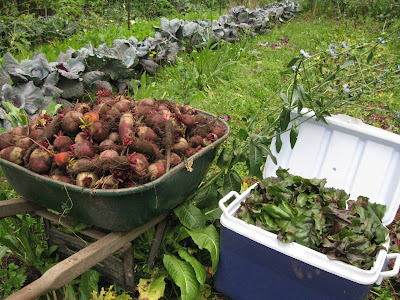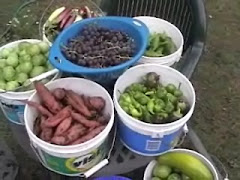
All in all the garden has been good to us this year, recent harvests have yielded fairly decent amounts of food for winter storage. My little helper and I were blessed with over 400 lbs of potatoes from five rows totalling 160' in length, this is about a hundred pounds less than I had hoped for but more than enough to see us through the cold months...I just won't be sharing any with the chickens as had originally been planned. Next year we will plant more potatoes.
We track the weight of our tomatoes, potatoes, and onions to help us evaluate production, that coupled with the fact that since these crops are gathered in five gallon buckets it is just too easy not to.

Numerous different potato varieties were planted this season and all but one,
Butterfinger , did well. Most of our spuds were small to medium in size...not a lot of big ones this time around. Pictured below are Russian Banana and Red Thumb. Russian Banana normally produces more potatoes per plant than any other variety we grow.
This year's potatoes were planted fairly intensively and yielded around 6-8 tubers per plant. They were planted 12" deep and I did not "hill them up" at all this summer. Because we have chosen to keep our aisle ways so very narrow, practically disappearing by mid-summer, it is difficult for me to hill up potatoes so I have found that
deep planting makes up for this in our garden.
In 2012 I hope to experiment with more of a
dryland farming technique with some of our potato crop that involves depending upon using only natural occurring rain water, wide spacing, and dirt/
dust mulch to help with water retention. This will be done in an area separate from our main garden, we have a 3 acre field that is not cost effective to irrigate and need to start putting it to good use with something besides knapweed. For quite some time now one of my concerns has been that we are far too dependent upon irrigation and I would like to learn more about growing crops with less water and potatoes would seem to be a great dryland crop to experiment with. A
fellow blogger , in a somewhat similar climate, has had great success with this type of farming and it would seem to be a much more sustainable manner in which to grow crops allowing us to shed some of our dependence on water pumped to us via electric power.

Our spring planted garlic experiment turned out all right, the cloves are a little on the small side but so is/was most everything else this year. We planted our garlic in the early spring because in previous winters too much snow cover has allowed
voles unhindered access to a smorgasbord of fall planted bulbs and too little snow, coupled with lots of rain, has sometimes led to rotten garlic. I think I'll give the spring planting a try again next season and then decide which period of planting works best for us.

2011 was our best harvest ever with a couple hundred pounds of nice sized onions. We grew Stuttgarter, Yellow of Parma, Varsity, Jaune Paille Des Vertus, Utah, and a few Candy onions. I tried growing Walla Walla Sweets from starts again but they all shriveled up and died... probably due to our cold rainy spring weather. This will be the last time I will bother with that particular variety as they have rarely turned out for me.

The tomatoes did better than I had originally expected and should allow for a good amount of canned sauce which we will continue working on as they slowly finish ripening on our porch. Our 2011 tomato crop weighed in at close to 300 lbs, which is almost half of what we produced last year.
Our goal is to get an average yield of 5-10 lbs per plant, some will provide many more fruits some less. We grow a variety called De Tiganesti that provided nearly 20 lbs per plant whereas our Black Krim and Coastal Pride varieties only shared 4-5 tomatoes per plant with us...but their flavor more than made up for the lack of productivity.


We were very pleased with our peppers, especially considering the long cold spring we experienced, and have been freezing and eating them fresh since mid July. I picked the last few of them yesterday and will store them in the below bins until we use them up, if the weather remains cool they should keep just fine for a month or so.

The Grandson was more than happy to help pick apples, some of our trees are finally starting to produce decent amounts of fruit. The tree the boy is picking from is a Cortland. We are using these for storage and picked many pounds of mixed wild apples that were canned up as sauce.

These Spitzenberg apples have become one of my favorites for fresh eating. We were delighted to get around 40 lbs off this 6-7 year old tree.

Next up we will be harvesting beets, carrots, parsnips, cabbage, endive, celery, and so on.
 This past May we had a tree fall on our house, we were standing right there as it happened...kind of scary. Lucky for us insurance more than covered the repair cost and I was able to fix the roof myself. So this week we took out seven large trees, two of which were totally dead and the other four had dead tops, as a preventative measure. Guess that takes care of next year's firewood...and then some. This will spare us and our poor old truck the challenge of driving winding mountain roads next spring in our annual trek for firewood. Always nice to be one step ahead of the game.
This past May we had a tree fall on our house, we were standing right there as it happened...kind of scary. Lucky for us insurance more than covered the repair cost and I was able to fix the roof myself. So this week we took out seven large trees, two of which were totally dead and the other four had dead tops, as a preventative measure. Guess that takes care of next year's firewood...and then some. This will spare us and our poor old truck the challenge of driving winding mountain roads next spring in our annual trek for firewood. Always nice to be one step ahead of the game.




































